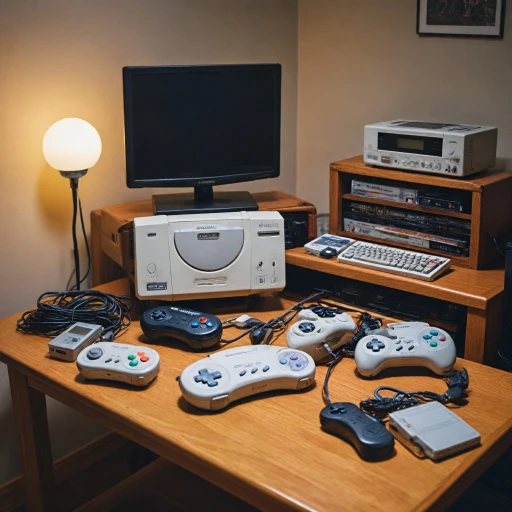The Origins of Sega Controls
The Birth of a Gaming Icon
The era of Sega controls began with a groundbreaking approach to video game interaction. As the gaming industry blossomed in the late 20th century, Sega introduced its innovative control system through its consoles, namely the Master System and the Sega Genesis. These systems were pivotal in setting a new course for gaming experiences.
The original Master System, which was released in the United States and North America, brought forth a simpler control pad design. With basic buttons and a directional pad, it offered a straightforward yet effective way for players to engage with games such as "Sonic the Hedgehog." As the industry thrived, Sega released the Sega Genesis, also known as the Mega Drive in Europe and other regions, elevating the dynamics of gaming further.
The Sega Genesis controller retained the traditional control pad design but featured an expanded set of buttons. This added depth to the gaming experience and enabled developers to create more complex game mechanics. The Genesis Mega release began to steer focused attention toward refined control systems, which significantly enhanced player immersion.
With its launch, the Genesis Mega drive cemented Sega's place in the console market, competing alongside heavyweights like Nintendo, Atari, and new entrants such as Sony PlayStation and the emerging Game Boy. As players across the globe, from North America to Europe, flocked to buy Sega systems, they soon realized the importance of effective controller design in shaping gaming joy.
This ingenuity laid the groundwork for developments in the innovations of their subsequent systems, including the Sega Saturn and inspired feature evolution seen in contemporary titles such as Nintendo Switch and the gray Sega Saturn's unique features. Understanding these early controls offers insight into the ever-evolving relationship between players and their gaming consoles.
Innovative Features of Sega Controllers
Innovations and Technological Advancements in Sega Controllers
With the evolution of gaming systems, Sega consistently pushed the boundaries of what a controller could achieve, introducing several innovative features that set the standard in the industry. One of the key introductions was the Genesis controller, later followed by multiple compelling variations, such as the distinct Sega Saturn control pads, which highlighted Sega's innovative thrust. While earlier models featured a simpler configuration, allowing players to get immersed in their favorite video games with ease, later versions unveiled more sophisticated features, combining ergonomic design with advanced functionality.
A defining advancement made by Sega was the introduction of the multi-button control pads, including the famous six-button arcade pad accompanying the Sega Mega Drive and Sega Genesis in North America and Europe. These buttons weren't just for aesthetics; they provided a seamless experience for fast-paced games like Sonic the Hedgehog. Prior to Sega's innovation, systems from Atari or Nintendo relied on a more limited button scheme, which sometimes restricted gameplay fluidity and depth.
Moreover, Sega's intuitive approach included the strategic placement of the start button and the enhancement of grips for player comfort during long gaming sessions. The impact of these advancements was felt far and wide, influencing contemporaries like Sony PlayStation and even modern iterations seen in the Nintendo Switch Joy-Con controllers.
If you're intrigued by the rich history and innovation reflected in Sega's controllers, you might enjoy delving further into the Sega Saturn, a console that continues to captivate vintage enthusiasts.
Impact on Gaming Experience
Enhancing the Gaming Experience with Sega Controls
The evolution of Sega controls has significantly shaped the gaming experience, particularly during the era of the Sega Genesis and Mega Drive. The introduction of the six-button arcade pad was a game-changer, offering a more intuitive and responsive feel compared to earlier models. This allowed players to execute complex moves with greater ease, especially in fast-paced arcade games like Sonic the Hedgehog and fighting games that required precise inputs.
When Sega released its consoles, the control pads were designed to cater to the needs of both casual and hardcore gamers. The ergonomic design of the Sega Genesis controller, with its strategically placed start button and comfortable grip, made long gaming sessions more enjoyable. This was a stark contrast to some of its competitors, such as the Nintendo and Atari systems, which had simpler button layouts.
In comparison to its rivals, the Sega control pads offered a unique blend of innovation and functionality. While Nintendo's controllers were known for their simplicity, Sega's controllers provided more buttons and options, appealing to gamers who craved a more immersive experience. This difference was evident in the way Sega's control pads enhanced the gameplay of titles like Sonic the Hedgehog, which required quick reflexes and precise control.
The impact of Sega's controllers was not limited to the gaming experience alone. Their design influenced future consoles, including the Sony PlayStation and even modern systems like the Nintendo Switch. The legacy of Sega's control innovations continues to be felt today, as seen in the retro bit variations that pay homage to the classic Sega designs.
For more insights into how these controllers have influenced modern gaming, you can explore the legacy of PlayStation 2 games, which also drew inspiration from Sega's pioneering designs.
Comparing Sega Controls to Competitors
Facing Off Against the Competition
In the era when the Sega Genesis was released, the gaming console market was bustling with competition, primarily dominated by giants like Nintendo and Atari. Nintendo’s systems, such as the Nintendo Entertainment System and later the Super Nintendo Entertainment System, were the kings of the arcade and home gaming. Their controllers, known for intuitively designed control pads and buttons, had set a high standard in the industry. Sega's approach with the Genesis was quite different. When they released their console in North America, it was under considerable pressure to stand out amidst these formidable competitors. The Genesis controller, hailed for its ergonomic design, featured a three-button layout with a start button that was more compact and comfortable when compared to other control pads during that time. As gaming evolved, Sega introduced the Sega Saturn and Sega Mega Drive in various regions like Europe and the United States. These systems continued to challenge Nintendo and the emerging Sony PlayStation systems, integrating innovative button arcade experiences and a slightly more sophisticated layout than previous models. In Arcade gaming, Sega’s control pads appealed to those who preferred classic and more interactive engagements. For instance, players of iconic games like Sonic the Hedgehog found the button configurations distinct and immersive, thus amplifying their overall gaming experience. Despite the advancements, Sega's competitors eventually adopted features that Sega had pioneered. Systems like Sony’s PlayStation and Nintendo’s later releases, including the Joy-Con controllers for the Nintendo Switch, began to incorporate design aspects drawn from Sega’s earlier innovations, showcasing the lasting impact Sega had on video game controller development. As we reflect on competition dynamics, it is evident that Sega's controllers weren’t only pioneers in ergonomics and design but also integral in pushing other companies to innovate for better gaming systems and experiences. This evolution shaped the future of video gaming controllers, influencing even modern designs we see today on platforms beyond Sega's era.Legacy and Influence on Modern Controllers
The Enduring Legacy of Sega's Control Designs
Sega's control pads have carved a unique niche in the gaming landscape, leaving a significant imprint on the evolution of gaming peripherals. The designs, first seen in systems like the Sega Master System and Sega Genesis, are characterized by their intuitive button placements and ergonomic designs. These innovations have stood the test of time, with various adaptations influencing even the most contemporary of gamer experiences.
One of Sega's most notable contributions came with the three-button control pad, later expanded to six buttons to accommodate complex arcade games. This layout has resonated throughout the gaming community, inspiring other companies, such as those behind the Sony PlayStation and Nintendo Switch, to create similarly user-friendly controllers. The seamless transition between systems and the familiarity of Sega's control schemes have made them a staple for retro gamers and nostalgia-driven collectors alike.
In North America and Europe, where the Sega Genesis (or Mega Drive) dominated the 16-bit era, gamers fondly recall the control pads that introduced them to epic adventures like Sonic the Hedgehog. This widespread adoption not only solidified Sega's place in gaming history but paved the way for variations such as the modern Retro-Bit Sega controllers, which strive to capture the essence of the originals while providing updated functionalities.
Despite the intense competition from Nintendo and Atari during the formative years of video game consoles, Sega control pads managed to establish their unique identity. The legacy left by these controllers is evidenced by their frequent nods and homages in contemporary hardware. Today's consoles, whether from the PlayStation lineup or those designed to switch between home and portable modes like the Nintendo Switch, often draw on principles established by Sega's original designs.
In examining the evolution of a control system, it's clear that Sega’s contributions have not only shaped past gaming experiences but continue to influence modern console design. As the industry evolves, the ideals first put forth by Sega’s control innovations will likely persist, ensuring their place in gaming history for generations to come.












